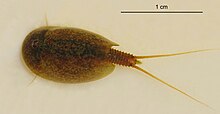Lepidurus apus
| Lepidurus apus | |
|---|---|
 |
|
| Scientific classification | |
| Kingdom: | Animalia |
| Phylum: | Arthropoda |
| Class: | Branchiopoda |
| Order: | Notostraca |
| Family: | Triopsidae |
| Genus: | Lepidurus |
| Species: | L. apus |
| Binomial name | |
|
Lepidurus apus (Linnaeus, 1758) |
|
Lepidurus apus, commonly known as a tadpole shrimp, is a notostracan in the family Triopsidae, one of a lineage of shrimp-like crustaceans that have had a similar form since the Triassic period and are considered living fossils. This species is cosmopolitan, inhabiting temporary freshwater ponds over much of the world, and the most widespread of the tadpole shrimps. Like other notostracans, L. apus has a broad carapace, long segmented abdomen, and large numbers of paddle-like legs. It reproduces by a mixture of sexual reproduction and self-fertilisation of females.
Lepidurus apus grows to 42 mm–60 mm in length. Its long abdomen is divided into about 30 segment-like rings, with two long caudal rami or "tails" attached behind the last ring. Between the tails is a projection which distinguishes Lepidurus from Triops, the other notostracan genus. Its carapace is flat with an average length of 19 mm, and is attached only at the front, covering up to two thirds of the abdomen. The carapace is a mottled dark yellow/brown colour transitioning to a lighter edge, and bears a single pair of compound eyes. At the front of the abdomen are one or more (up to three) pairs of feelers. Under the body are 41–46 (average 44) pairs of paddle-like limbs used for swimming.
Males are readily identifiable by the lack of ovisacs, and also have subtle differences in the carapace. Females and hermaphrodites look virtually identical, but hermaphrodites have testicular lobes amongst their ovarian lobes, which allows them to reproduce in isolation.
L. apus is often referred to as a ‘living fossil’, virtually unchanged for over 300 million years. However, a recent study suggests that resemblance to fossil notostracans is probably a result of the "highly conserved general morphology in this group and of homoplasy". Recent species of Lepidurus are morphologically nearly identical to fossil records but may "represent very different evolutionary lineages".
Lepidurus apus is perhaps the most cosmopolitan of all the Notostraca, occurring widely around the world including, but not limited to, New Zealand, Australia, Iran,France, Germany, Italy,Denmark,Morocco, and Austria. Lepidurus apus is split into several geographic subspecies, such as L. apus viridis, present in parts of Australia, Tasmania and New Zealand.
...
Wikipedia
